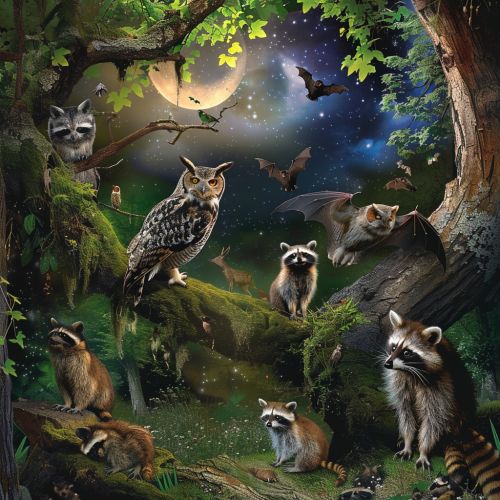Nocturnal
Introduction
Nocturnality is a behavioral characteristic of being active during the night and sleeping during the day. This trait is common in various species of animals, plants, and even microorganisms. It is an evolutionary adaptation that allows organisms to avoid heat and predation, and exploit different food resources. Nocturnal behavior can be observed in a wide range of taxa including mammals, birds, reptiles, insects, and plants.


Adaptations
Nocturnal organisms have evolved several physical and behavioral adaptations that enable them to thrive in the dark. These adaptations include enhanced senses of hearing, smell, and touch, as well as specialized visual adaptations.
Visual Adaptations
Nocturnal animals often have large eyes in relation to their body size to maximize light capture. The eyes of many nocturnal animals contain a layer of cells called the tapetum lucidum, which reflects light back through the retina and enhances night vision. Additionally, nocturnal animals typically have a high proportion of rod cells in their eyes, which are more sensitive to light and motion than cone cells.
Sensory Adaptations
In addition to visual adaptations, nocturnal animals have evolved enhanced senses of hearing, smell, and touch. Many nocturnal animals, such as bats and owls, have highly developed auditory systems that allow them to locate prey and navigate in the dark. Similarly, many nocturnal mammals have a highly developed sense of smell, which they use for locating food, marking territory, and communicating with other members of their species.
Nocturnal Animals
There is a wide variety of nocturnal animals, each with unique adaptations and behaviors that enable them to thrive in the darkness.
Mammals
Many mammals are nocturnal, including most rodents, bats, and many carnivores. These animals have evolved to be active at night to avoid predation and competition for resources.
Birds
While most birds are diurnal, there are several species that are nocturnal, including many species of owls and nightjars. These birds have evolved to hunt at night, taking advantage of the reduced competition for food resources.
Reptiles and Amphibians
Many reptiles and amphibians are also nocturnal, including many species of snakes, geckos, and frogs. These animals often spend the day hiding in cool, damp environments and become active at night when temperatures are more moderate.
Insects
Many insects are nocturnal, including most species of moths, many beetles, and some ants. These insects often use the cover of darkness to avoid predation and take advantage of the cooler temperatures.
Nocturnal Plants
While most plants are not considered nocturnal in the traditional sense, many have adapted to perform important functions during the night. For example, many desert plants, such as cacti, open their stomata (pores) at night to minimize water loss. Additionally, some plants, such as the evening primrose and the moonflower, bloom at night to attract nocturnal pollinators like moths.
Impact on Human Society
Nocturnal animals have a significant impact on human society. They play important roles in ecosystems as predators, prey, and pollinators, and their behaviors and adaptations have been the subject of extensive scientific study. Additionally, nocturnal animals often feature prominently in human culture and mythology.
